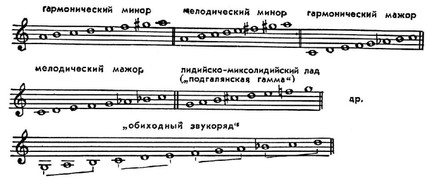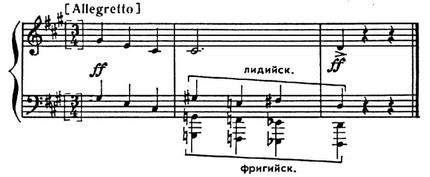
Diatonic |
from the Greek dia – through, along and tonos – tone (whole tone), letters – going along the tones
A seven-sound system, all sounds of which can be arranged in perfect fifths. Such, for example, is the sequence of intervals in other Greek. diatonic tetrachord: e1 – d1 – c1 – h (two whole tones and a semitone), in contrast to the sequence of chromatic intervals. tetrachord e1 – des1 – c 1 – h (no whole tones). Diatonic are those intervals and chords that can be obtained within a chain of six fifths (an example is given in the key of C-dur):

(sometimes a tritone as a variant of a pure fourth or a pure fifth is taken not as a diatonic, but as a chromatic interval).
There is a strict relationship between the number of intervals of the same type and the number of fifth steps (Q) forming this interval in a pure D.. The number showing how many times a given interval occurs in the system is equal to the difference between the total number of sounds in the system and the number of fifth steps:
h. prima, h. octave (0Q) occurs 7 times (7-0), h. fifth, h. quart (1Q) occurs 6 times (7-1), b. second, m. seventh (2Q) occurs 5 times (7-2), b. sixth, m. third (3Q) occurs 4 times (7-3), b. third, m. sixth (4Q) occurs 3 times (7-4), b. seventh, m. second (5Q) occurs 2 times (7-5), tritone (6Q) occurs 1 time (7-6).
Intervals are also considered diatonic in those cases when they are formed by chromatically changed steps (for example, as-b is a diatonic whole tone, both out of context and in key, for example, in C-dur). The same applies to chords (eg, ges-b-des in C-dur is a diatonic chord on a non-diatonic scale). Therefore, G. L. Catoire distinguishes a chromatic chord. essentially (for example, d-fis-as-c) and chromatic. by position (for example, des-f-as in C-dur). Many ancient Greek modes are diatonic, as well as medieval modes and other natural modes, including the now widespread Ionian (natural major) and Aeolian (natural minor) modes:

In a broader sense, the so-called. conditionally diatonic modes, variable diatonic modes, systems and scales (see mode). In some of these modes, along with tones and semitones, magnification also enters. second.
Anhemitonic pentatonic (according to the terminology of Catoire, “protodiatonic”) and Middle Ages. hexachords can be interpreted as incomplete diatonic. systems.
Sometimes 12-sound (12-step) systems are called diatonic, each step in which is treated as independent. At the same time, a different meaning is put into the concept of D.: D. as a set of basic. steps (A. S. Ogolevets, MM Skorik).

In other Greek. D. music was one of the three modal moods (“genera”), along with chromaticity, which used two small seconds in a row, as well as an increase. second, and anharmonics, the specifics of which were intervals less than a semitone. In this Greek the music is similar to other ancient monophonic cultures, especially those of the Near East and the Mediterranean.
The diverse forms of D. form the basis of the Western European. and Russian folk-song art, as well as prof. European music (Gregorian chant), especially after the approval of polyphony as the predominant type of music. presentation. harmonic the unification of voices is carried out primarily with the help of the connecting action of the simplest consonances – fifths and fourths, and the fourth-quint coordination of voices contributes to the manifestation of diatonic. relations.
The system of hexachords, widespread since the time of Guido d’Arezzo (see Solmization), was fixed within the framework of the general diatonic. system modal variability (especially in shifts

-molle and

-durum, i.e. b and h). Similar modal variability is also characteristic of Russian. church music (h below and b above, see “everyday scale” in the example above). Related to this is the practice of notating voices with dec. key characters, eg. without signs in the upper voice and with one flat in the lower.

G. de Macho. Ballad 1. Ci comencent les balades ou il ha chant, bars 1-3.
With the establishment of the dominance of “harmonic. tonality”—major and minor (since the 17th century), a new type of instrumentation, based on func. a system of three main triads – tonics, dominants and subdominants, interconnected by the strongest fifth relationship. Limiting centralization of mode based on func. harmony leads to the formation of new chord-harmonic. connections of the tones of the mode (for example, in C-dur, tone d is connected with the prima of the tonic through the main tone of the dominant g, tone e – belonging to the tonic triad, f – as the main tone of the subdominant, etc.), which is realized in sequences of chords (theoretically substantiated by J. F. Rameau). Non-diatonic Elements and chromatics are formed on the basis of D. both melodically and chordally-harmonically by alteration, mixing of dissimilar diatonic instruments. elements in succession and in simultaneity (polydiatonic).
At 19 – beg. In the 20th century, on the one hand, the old D. was revived and D. Nar. warehouse and close to it (in F. Chopin, F. Liszt, E. Grieg, K. Debussy, especially in Russian composers – M. I. Glinka, M. A. Balakirev, N. A. Rimsky-Korsakov, M. P. Mussorgsky and others).
On the other hand, there is a transition to chromaticity as the basis of the height structure. The beginning of this process was put by “Tristan” by R. Wagner. Completely switched to chromatic plural. composers of the 20th century, especially representatives of the new Viennese school.

A. K. Lyadov. Eight Russian folk songs. III. Drawstring.
In the music of the 20th century various types of D. are used: D. nar. warehouse, close to the classic. major and minor; D. in decomp. modifications, polylady, polydiatonic. combinations (I. F. Stravinsky, S. V. Rachmaninov, S. S. Prokofiev, D. D. Shostakovich, B. Bartok). Often D. remains only as a basis, more or less veiled (S. S. Prokofiev, D. D. Shostakovich, P. Hindemith), or appears as an integral element of non-diatonic. structures (diatonic fields are marked in parentheses):

S. S. Prokofiev. “Betrothal in a monastery” (“Duenna”). 2nd picture, the end.
References: Serov A. N., Russian folk song as a subject of science, “Musical Season”, 1869/70, No 18, 1870/71, No No 6 and 13; Petr V.I., On compositions, structures and modes in ancient Greek music, K., 1901; Catuar G. L., Theoretical course of harmony, part 1, M., 1924; Tyulin Yu. N., Teaching about harmony, part 1, L., 1937, 1966; his own, Natural and alteration modes, M., 1971; Ogolevets A. S., Fundamentals of the harmonic language, M.-L., 1941; Kastalsky A. D., Fundamentals of folk polyphony, M.-L., 1948; Sposobin I. V., Elementary theory of music, M., 1951, 1958; Kushnarev X. S., Questions of the history and theory of Armenian monodic music, L., 1958; Berkov V. O., Harmony, part 1, M., 1962; 1970; Skorik M. M., Prokofiev and Schoenberg, “SM”, 1962, No 1; Karklin L. A., Generalize practical experience, “SM”, 1965, No 7; Sohor AH, On the Nature and Expressive Possibilities of Diatonicism, in: Questions of Theory and Aesthetics of Music, vol. 4, L.-M., 1965; Sposobin I. V., Lectures on the course of harmony, M., 1969; Kotlyarevsky IA, Diatonics and Chromatics as a Category of Musical Myslennia, Kipv, 1971; Bochkareva O., On some forms of diatonic in modern music, in: Music and Modernity, vol. 7, M., 1971; Sigitov S., Bela Bartok’s modal system of the late period of creativity, in collection: Problems of mode, M., 1972.
Yu. H. Kholopov



